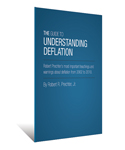Social psychology precipitates economic depressions
Don’t blame Martin Van Buren for America’s first deflationary depression. Social mood rode higher in the saddle than did our 8th President, who only stood 5′ 6″.
Elected in 1836, by the time Van Buren assumed office in March 1837 a speculative bubble had burst and a banking crisis was at hand (sound familiar?) — the national mood had turned south and the “Panic of 1837” followed. Van Buren was known as “The Little Magician,” but he could not pull an economic recovery out of the hat. He met defeat seeking a second term.
America’s first deflationary depression lasted until 1842. Van Buren blamed over-zealous business practices and a credit bubble (sound familiar 2x?). The panic precipitated bank failures; many speculators who bought land to capitalize on railroad expansion lost everything. The depression worsened as Van Buren continued Andrew Jackson’s economic policies. Businesses failed and unemployment was widespread. There were even “food riots” in several cities.
(Author’s note: Because of substantial revenue inflows into the Treasury during the boom of the early 1830s, the United States government became debt free in 1835. Ironically, this was the very year the depression began. Stock prices fell sharply despite the federal government paying off all of its debt. Conventional wisdom would have us believe reducing the national debt, or paying it off entirely, would lift stock prices. It didn’t happen in 1835, so there must be something else at work. That “something else” is social mood.)
The 1837-1842 deflationary depression comprised Supercycle Wave II, the end of which saw the beginning of the biggest economic expansion in history — Supercycle wave III! The 1929-1933 Great Depression still grabs more attention, but in fact the earlier Supercycle Wave II decline set the stage for the United States becoming the greatest economic and military power the world has ever known.
President Herbert Hoover held office during the 1929 Crash and onset of the Great Depression, a.k.a. Supercycle Wave IV. Yet no U.S. President has thus far been at the helm during a Grand Supercycle market decline. The last decline of that degree had its origin in the South Sea Bubble in 1720, when Great Britain’s King George I was on the throne. The rampant speculation of the time spread beyond the financial class, such that porters and ladies’ maids had enough money to buy their own carriages. Members of the clergy took part in the mania. Poof! Life savings were wiped out. England’s Postmaster General committed suicide. Hundreds of members of Parliament lost money. As for the directors of the South Sea Company itself, they were forced to give up their property and arrested to boot.
Martin Van Buren led the nation during our country’s first Supercycle depression — as President he was powerless to stop it. Who will occupy the Oval Office when the next Grand Supercycle depression develops? This we believe: That individual will be powerless to prevent it. He or she will only be a President.
What is more powerful than a President of the United States? The answer is “social mood.” How is this powerful force shaping the economy?
Discover the answer in the 90-page Free Report called the Deflation Survival Guide.
 Now is the time to prepare for a deflationary depression. Start by reading the 90-page free eBook, Deflation Survival Guide, which includes Robert Prechter’s most important analysis and forecasts regarding deflation. This guide will help you survive a major deflationary trend, and even equip you to prosper. Now is the time to prepare for a deflationary depression. Start by reading the 90-page free eBook, Deflation Survival Guide, which includes Robert Prechter’s most important analysis and forecasts regarding deflation. This guide will help you survive a major deflationary trend, and even equip you to prosper.
Download your free eBook, the Deflation Survival Guide, now >> |